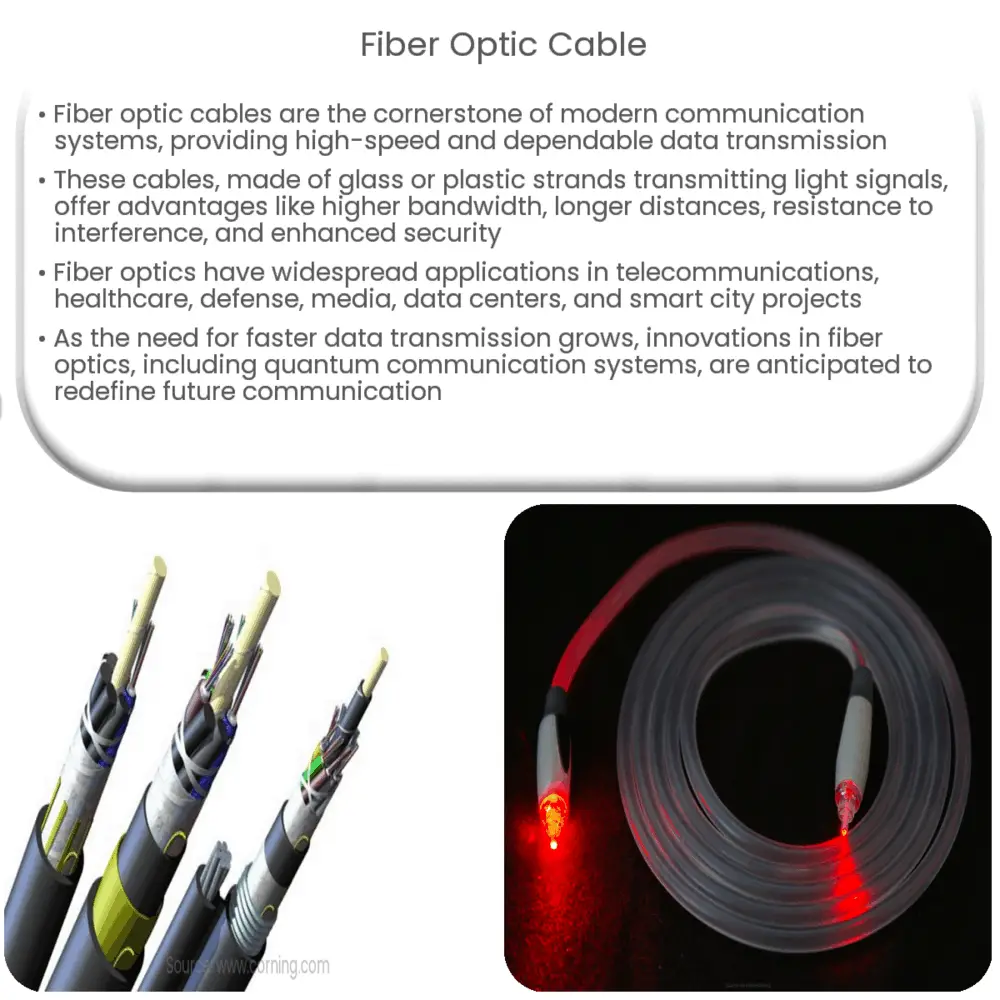Explore fiber optic cable technology, its advantages over traditional copper cables, applications across industries, and its future potential.

Fiber Optic Cable: Revolutionizing Communication and Connectivity
Introduction
Fiber optic cables have become the backbone of modern communication systems and networks, offering high-speed and reliable data transmission. These cables are revolutionizing the way we connect and communicate, facilitating advancements in various industries, such as telecommunication, healthcare, and defense. In this article, we will discuss the fundamentals of fiber optic cable technology, its advantages over traditional copper cables, and its applications in various fields.
Understanding Fiber Optic Cable Technology
Fiber optic cables are made of thin strands of glass or plastic, known as optical fibers, that transmit data in the form of light signals. These signals travel along the fibers through a process called total internal reflection, which enables the light to bounce off the fiber’s walls without losing significant intensity. The optical fibers are coated with a protective layer, typically made of plastic, to prevent damage and maintain signal quality.
There are two primary types of fiber optic cables: single-mode and multi-mode. Single-mode cables have a single path for light to travel, allowing for longer distances and higher bandwidth. Multi-mode cables, on the other hand, have multiple paths for light to travel, resulting in shorter distances but a greater capacity for simultaneous data transmission.
Advantages of Fiber Optic Cables
Fiber optic cables offer numerous advantages over traditional copper cables, making them the preferred choice for high-speed data transmission. Some of these advantages include:
- Higher Bandwidth: Fiber optic cables can transmit significantly more data at once than copper cables, making them ideal for high-speed internet connections and other bandwidth-intensive applications.
- Longer Distances: Data transmitted through fiber optic cables can travel much further without degrading in quality compared to copper cables, enabling better connectivity over long distances.
- Resistance to Interference: Unlike copper cables, which are susceptible to electromagnetic interference, fiber optic cables are immune to such disruptions, ensuring a more stable and reliable connection.
- Lightweight and Compact: Optical fibers are thinner and lighter than copper wires, making them easier to install and maintain. Additionally, fiber optic cables occupy less space, an important factor in data centers and other space-constrained environments.
- Enhanced Security: Fiber optic cables are more difficult to tap into without disrupting the signal, providing a higher level of security for sensitive data transmission.
Applications of Fiber Optic Cables
Fiber optic cables have a wide range of applications across various industries, including:
- Telecommunications: Fiber optic cables have become the standard for high-speed internet and long-distance phone services, offering faster data transmission and improved call quality compared to traditional copper cables.
- Healthcare: Fiber optic technology plays a crucial role in advanced medical equipment, such as endoscopes and surgical instruments, providing high-resolution imaging and precision control.
- Defense and Aerospace: Fiber optic cables are used in military communication systems, surveillance equipment, and aircraft, providing secure, reliable, and high-speed data transmission in challenging environments.
- Broadcasting and Media: Television networks and media companies utilize fiber optic cables for live event broadcasting and high-definition video transmission, ensuring high-quality signals and real-time data transfer.
- Data Centers: The high bandwidth and low latency offered by fiber optic cables make them ideal for data center connectivity, facilitating efficient data transfer and reducing network bottlenecks.
- Smart Cities and Infrastructure: Fiber optic networks form the backbone of modern smart city projects, supporting high-speed internet connectivity, traffic management systems, and advanced sensor networks for improved urban planning and public safety.
Fiber Optic Cable Installation and Maintenance
Installing and maintaining fiber optic cables require specialized tools, equipment, and skilled technicians. Some essential aspects of fiber optic cable installation include:
- Proper Planning: A detailed plan that takes into account the cable route, terrain, and existing infrastructure is crucial for efficient fiber optic cable installation.
- Splicing and Termination: Connecting and terminating fiber optic cables require precision and expertise, as improper splicing can lead to signal loss and reduced performance.
- Testing and Troubleshooting: Regular testing and monitoring of fiber optic networks are essential to ensure optimal performance and quickly identify and resolve any issues that may arise.
Future of Fiber Optic Cables
As the demand for high-speed internet and data transmission continues to grow, the importance of fiber optic cables in modern communication systems cannot be overstated. Technological advancements in fiber optics, such as photonic crystal fibers and multi-core fibers, promise to further enhance the capabilities of these cables, potentially offering even higher bandwidth and more efficient data transmission.
Furthermore, the development of quantum communication systems, which rely on the transmission of quantum information via optical fibers, could revolutionize data security and enable new applications in fields like cryptography and secure communication.
Conclusion
Fiber optic cables have transformed the way we communicate and access information, offering unparalleled speed, reliability, and security. As technology continues to advance, fiber optic cables are expected to play an even more critical role in shaping the future of communication, making it essential for individuals and organizations to understand and leverage their potential.

